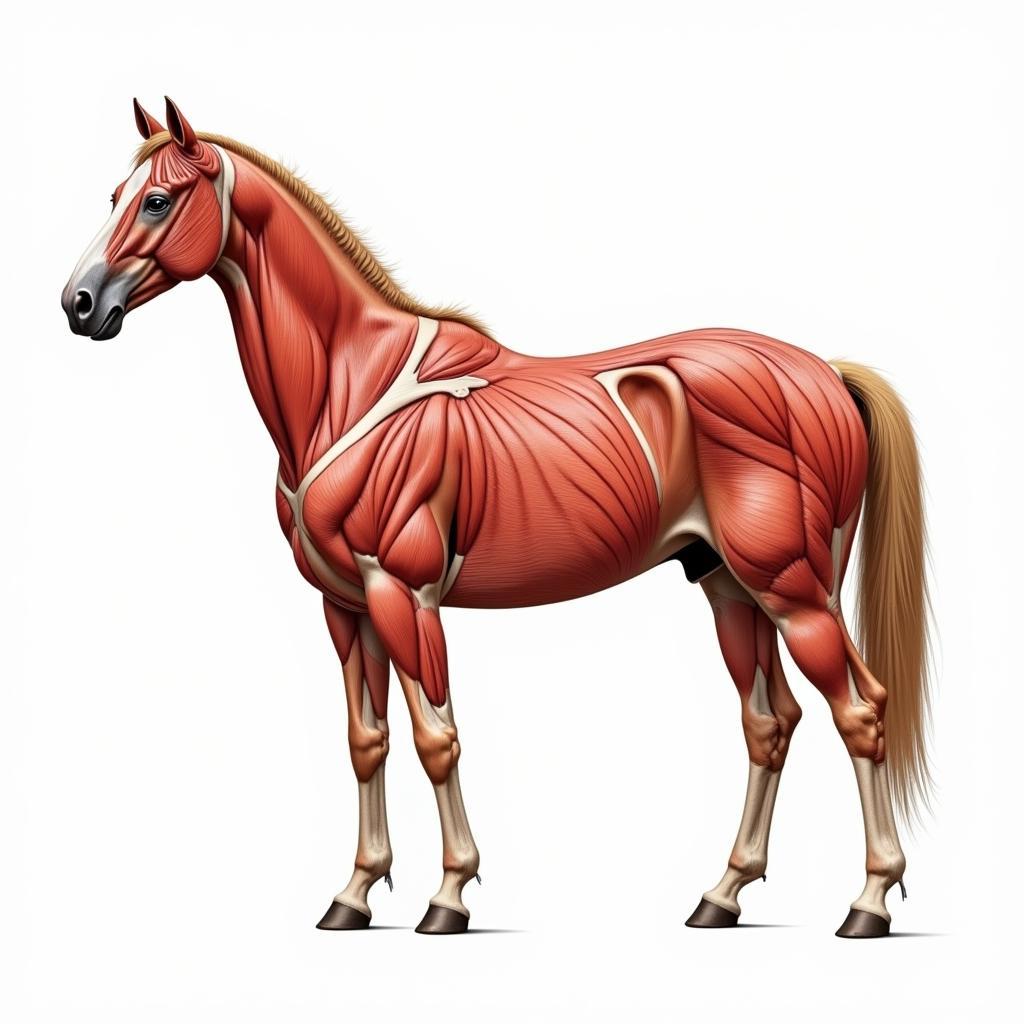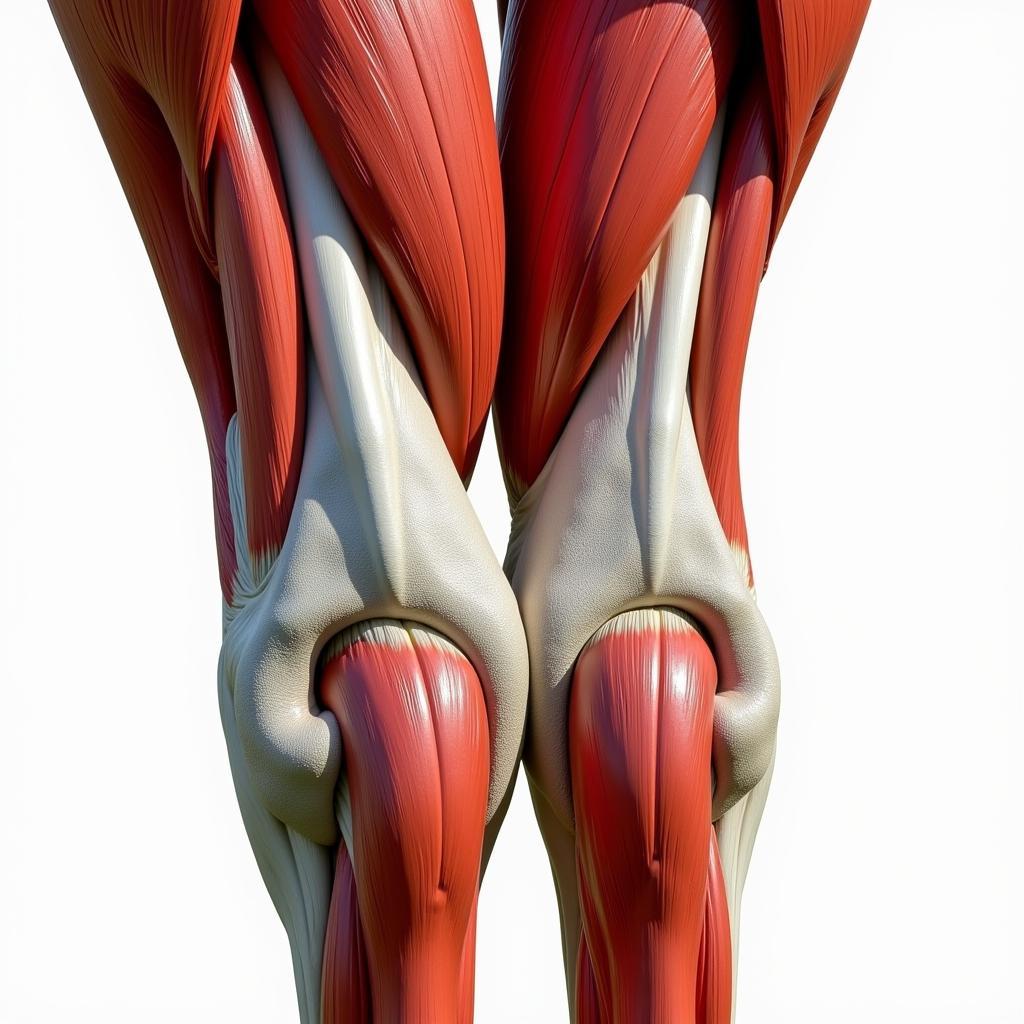The Horse Muscle System is a complex and fascinating network that powers every movement, from a gentle graze to a thundering gallop. Understanding how this system works is essential for any horse owner or enthusiast, as it provides insight into their athletic ability, overall health, and even their temperament.
 Equine Muscle Anatomy Chart
Equine Muscle Anatomy Chart
The Makeup of a Horse’s Muscles
Horses, like all mammals, possess three distinct types of muscle tissue:
-
Skeletal Muscle: This is the most prevalent type, responsible for voluntary movement. When we admire a horse’s powerful strides or precise footwork, we are witnessing skeletal muscles in action. These muscles are attached to bones via tendons, and their contractions create the force needed for locomotion.
-
Smooth Muscle: Found within the internal organs, smooth muscle controls involuntary actions. Digestion, regulation of blood flow, and even childbirth rely on the rhythmic contractions of these muscles, happening without the horse’s conscious control.
-
Cardiac Muscle: As the name implies, this specialized muscle is exclusive to the heart. Its tireless contractions pump blood throughout the horse’s body, ensuring the delivery of oxygen and nutrients vital for life.
 Horse Leg Muscle Structure
Horse Leg Muscle Structure
Muscle Groups and Their Functions
The horse’s body is a marvel of evolutionary engineering, with over 700 muscles working in perfect harmony. Let’s break down some of the key muscle groups and their roles:
1. Head and Neck: This area houses muscles responsible for facial expressions, chewing, swallowing, and the horse’s ability to nod, shake its head, and move its neck for balance and grazing.
2. Shoulders and Forelegs: These muscles power the forelegs’ forward movement and bear a significant portion of the horse’s weight, especially during activities like jumping.
3. Back and Abdomen: The muscles in this region support the spine, aid in breathing, and provide stability for the rider. A strong back and abdominal area are crucial for a horse’s overall health and performance.
4. Hindquarters: Often referred to as the “engine room,” the hindquarters are home to powerful muscles like the gluteals and hamstrings, which generate the propulsive force needed for speed and jumping.
Muscle Health and Care
Maintaining a healthy horse muscle system is paramount for their well-being and athletic potential. Here are some key considerations:
-
Exercise: Just like humans, horses need regular exercise to keep their muscles strong and flexible. The type and intensity of exercise should be tailored to the horse’s age, breed, and fitness level.
-
Nutrition: A balanced diet rich in protein, carbohydrates, and essential vitamins and minerals is crucial for muscle growth, repair, and energy production.
-
Hydration: Water is essential for muscle function. Dehydration can lead to muscle fatigue, cramping, and even more serious health problems. Always provide your horse with access to fresh, clean water.
-
Warm-up and Cool-down: Just like athletes, horses benefit from a proper warm-up before exercise and a cool-down period afterward. This helps prevent injuries and promotes muscle recovery.
-
Massage and Bodywork: Regular massage therapy and bodywork can help alleviate muscle tension, improve circulation, and enhance overall muscle health.
Recognizing Muscle Problems
As a responsible horse owner, it’s essential to be aware of potential muscle problems. Some common signs include:
- Lameness or Stiffness
- Muscle Swelling or Heat
- Reluctance to Move or Exercise
- Changes in Gait or Performance
- Behavioral Changes, such as Irritability or Depression
If you notice any of these signs, it’s crucial to consult with a veterinarian to diagnose and address the issue promptly.
The Importance of Understanding the Horse Muscle System
Delving into the complexities of the horse muscle system might seem daunting, but it’s a journey well worth taking for any horse lover. A deeper understanding empowers us to provide better care, recognize potential problems early, and unlock the full potential of these majestic creatures.
Remember, a healthy horse is a happy horse, and a well-informed owner is their greatest advocate.
FAQs About the Horse Muscle System
1. What is the largest muscle in a horse?
The largest muscle in a horse is the longissimus dorsi, which runs along the back and is crucial for supporting the spine and facilitating movement.
2. How many muscles does a horse use to move its ears?
Horses have an impressive 10 muscles controlling each ear, allowing them to rotate their ears almost 180 degrees!
3. Why do horses need strong back muscles?
A strong back is essential for supporting the rider’s weight, maintaining balance, and facilitating smooth movement.
4. Can you overwork a horse’s muscles?
Yes, just like humans, horses can experience muscle fatigue and injury if overworked. It’s essential to tailor exercise programs to the individual horse’s fitness level and avoid pushing them beyond their limits.
5. How can I tell if my horse is experiencing muscle soreness?
Signs of muscle soreness in horses can include stiffness, reluctance to move, changes in gait, and even behavioral changes like irritability.
For additional resources on horse health and care, check out our articles on:
Do you have more questions about your horse’s muscle system or overall health? Contact us today! Our team of experts at Justus Horses USA is dedicated to providing you with the information and support you need to keep your equine companion in peak condition.
Call us at: 0772127271
Email us at: [email protected]
Visit us at: QGM2+WX2, Vị Trung, Vị Thuỷ, Hậu Giang, Việt Nam
We offer 24/7 customer support to address all your equine needs.